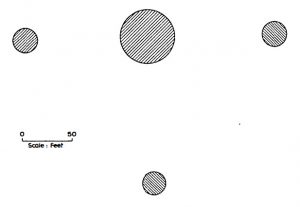Reports of Unidentified Flying Object: The English Corn Circles in 1988 – The Silbury Hill Circles
In mid-July a completely new chapter opened in the Circles saga. We were first aware that an enormous quintuple set of Circles had been found very close to Silbury Hill on July 15. This formation was far larger than anything previously seen, measuring about 2_90 feet across. Its situation beside the main A4 trunk road meant that no passing driver could avoid seeing it. Large numbers of cars stopped and their occupants went into the wheat field to visit the Circles, or climbed Silbury Hill to view this great imprint, which resembled the five faces of a giant dice.
Naturally, this mystery received extensive local TV and newspaper coverage. Apart from its size, the most remarkable thing about this Circle was its proximity to Silbury Hill, which is the largest prehistoric artificial mound in Europe. This 130-foot, flat-topped, conical barrow was constructed in elaborate layers in about 2600 BC for an unknown purpose. A ley line which runs through Avebury Stone Circle and Silbury Hill also crossed the position where this new set of Circles had appeared.
The central fifty-five-foot Circle was swirled in a clock wise spiral, and its satellites, each about twenty-one feet in diameter, were anti clockwise but for the clockwise northerly one, which was nearest to Silbury Hill . Shortly afterward a further quintuple set was found a mile to the west near Beckhampton. This was of similar size, but with smaller fifteen-foot satellites, three of which were clock wise and one anticlockwise. This completely new feature-the asymmetric disposition of the satellite circles’ swirl-tempted one to think that these new Circles presented some coded clue as to their origin or purpose. Quite apart from this, the sheer size of these quintuples, in which the satellites were roughly 100 feet distant from the main circle, was unprecedented.
On July 24 we discovered a third huge formation in a remote area nearly three miles west of Silbury Hill, and well away from the road. It is known as “Rupert’s Circle” (after discovery by my son, Rupert). This was of similar size to the first two quintuples, but completely lacked one satellite, the most northerly. The east and west satellites were both twenty-four feet in diameter and were swirled anticlockwise and clockwise respectively. The southern most satellite was only twenty feet in diameter, anti clock wise, and separated by a record 140 feet from the main Circle. The distortion of the regular quintuple set shape was unexpected, but not inexplicable in the light of sub sequent investigation. And here, once more, despite being first on the scene as far as we could tell, we could see the small tracks between the satellites and the main circle, which characterized all of these large quintuples.


Curiously, all three of these large quintuples lay close to the line of an ancient Roman road. So too had the Oadby Circle. Most likely this was purely coincidental, but such is the strangeness of this phenomenon that it is perhaps worth bearing in mind. And in each case one of the two axes of the formation was exactly parallel to the tractor “tramlines” in the field. This could hardly be mere chance, and this “locating” of the formations can immediately be seen from the photographs (Photos 10 and 11 and Figure 3:7). To any objective observer, one thing was by now abundantly clear: the Circle formations were not just randomly positioned, as one might expect of a completely natural phenomenon, but appeared to be intelligently located with respect to linear features of the landscape-not something necessarily requiring high intelligence, but intelligence nevertheless.
